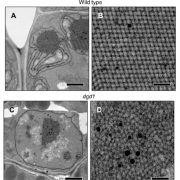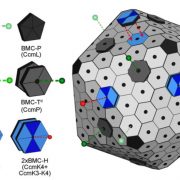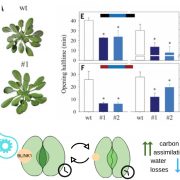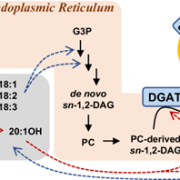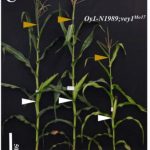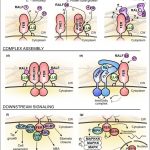Modifying plant photosynthesis and growth via simultaneous chloroplast transformation of Rubisco large and small subunits (Plant Cell)
 In an interesting evolutionary artifact, the genes encoding the small subunit of Rubisco, rbcS, reside in the nuclear genome, whilst those encoding RbcL persists in the chloroplast. The RbcS protein is translocated into the chloroplast where the holoenzyme forms. This complexity adds to the challenge of engineering Rubsico, and several efforts have been made to overcome it. Here, Martin-Avila et al. have developed a tobacco line with all the endogenous rbcS genes silenced by RNAi, and with the rbcL gene substituted with a bacterial gene that encode the L2 form of Rubisco that does not assemble with the small subunit. These plants can be used to explore new variations of Rubisco. The authors introduced combinations of rbcS and rbcL genes from various sources into the plastid genome and also optimized the rbcS gene for expression and translation in the plastid. These studies allow the activity of engineered Rubisco subunits to be assayed in vivo. (Summary by Mary Williams @PlantTeaching) Plant Cell 10.1105/tpc.20.00288
In an interesting evolutionary artifact, the genes encoding the small subunit of Rubisco, rbcS, reside in the nuclear genome, whilst those encoding RbcL persists in the chloroplast. The RbcS protein is translocated into the chloroplast where the holoenzyme forms. This complexity adds to the challenge of engineering Rubsico, and several efforts have been made to overcome it. Here, Martin-Avila et al. have developed a tobacco line with all the endogenous rbcS genes silenced by RNAi, and with the rbcL gene substituted with a bacterial gene that encode the L2 form of Rubisco that does not assemble with the small subunit. These plants can be used to explore new variations of Rubisco. The authors introduced combinations of rbcS and rbcL genes from various sources into the plastid genome and also optimized the rbcS gene for expression and translation in the plastid. These studies allow the activity of engineered Rubisco subunits to be assayed in vivo. (Summary by Mary Williams @PlantTeaching) Plant Cell 10.1105/tpc.20.00288


